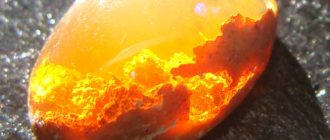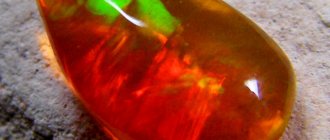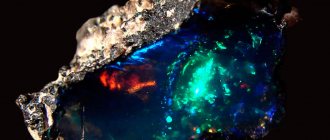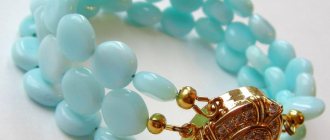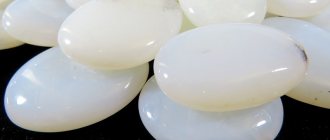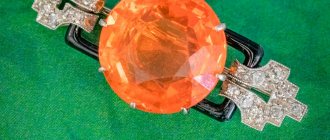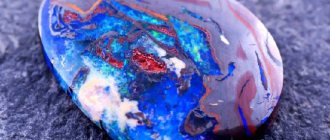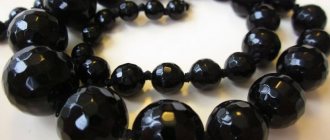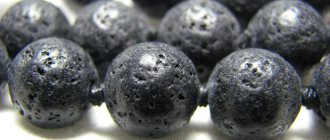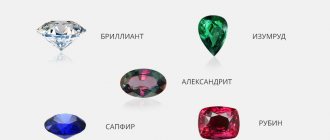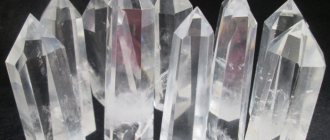How wonderfully precious opal plays!
It has the shine of the sun and the ebb of the moon.
It seems like there is a variable flow of life in it
And the quiet beauty of the silence of the night...
P.L. Dravert
The most interesting description of an unusual gem was found in the book “The Secret of the River of Evil Spirits.” It was written by a geologist in love with stones. You can learn a lot of interesting things about gems and how they are formed from a fiction (!) book for teenagers.
This is a description of a noble Brazilian opal.
“At first glance, it is a small light gray stone, so inconspicuous that if you come across it on the road, you will be too lazy to bend down (pick it up). And in this stone... in its depths, bright, clean lights lit up. Red, blue, green... The stone didn't just glow. It was burning with multi-colored lights. The illusion was so strong that everyone who took it in their hands involuntarily touched their fingers to ... the place from which the lights were breaking out to make sure that it was not heated.”
Opal: legends and myths
There are many of them among different nations.
Australia, rich in opals, believes that gems are traces of the Creator of the World.
In India they will tell you a myth about a woman who was running away from being pursued by a man. She ran away, tripped, fell... No, she didn’t lose consciousness. But when it fell, amazingly beautiful stones scattered from it.
Ancient Greek tale. When Zeus and his sisters and brothers pushed their daddy Kronos off the throne (there was a reason), Zeus burst into tears of happiness. Tears fell to the ground and turned into rainbow stones.
Consultations with historians did not confirm this version. There is no myth about opal and the tears of Zeus.
But there is this ancient Greek myth: Kronos was predicted that he would be overthrown by his own children. So he decided that the appropriate solution would be to swallow the kids. The Stone of Zeus, according to one myth, is the same stone that Kronos swallowed instead of the newborn Zeus. And Rhea’s wife slipped the stone into the diapers (Oops, Ops). The poor goddess is tired of giving birth to children and giving them to her heartless husband to feed.
I recommend watching the video about the secrets of opal.
Why opal?
It is generally accepted that the name may have come from "upala" (Sanskrit) - stone.
“ Enchanting sight ” - this is how the name of the gem is translated from Latin.
Pliny the Elder believed that the name is related to Ops - the goddess of fertility, the wife of Saturn (among the Greeks Kronos), the ancient Roman god of agriculture. God was stern and often ate his children. Some of the Saturnalia (festivals in honor of Saturn) were dedicated to Ops and were called “Opalia”.
Informative: some rituals from the Saturnalia are repeated in Christian Christmastide.
The Indians, with their ardent love for stones, were the first to notice opal. From India the gem came to Europe.
Interesting: NASA reported in 2008 that opals had been found on Mars.
Alexandrite: $70,000 per carat
This is a separate case in the story about precious stones. The previous ones are known for their specific shades. Alexandrite is a chameleon in the world of precious stones. It can really change its shade. It is thanks to this feature that it is called an emerald by day and a ruby by night.
The stone was first discovered in the Urals in 1830. Afterwards it was also found in East Africa, Brazil and Sri Lanka.
Physics and chemistry of gems
The opal mineral is a silica hydrogel. Contains up to 10% water (sometimes more).
The difference in color of multi-colored stones is due to the presence of impurities:
- iron;
- manganese;
- nickel.
Physical characteristics of the gem:
- can be transparent to almost opaque;
- pearlescent, glass luster;
- hardness from 5.5 to 6.5 on the Mohs scale;
- color from colorless, milky white, yellow, red, green, black.
Depending on the color, some types of stone are given their own names.
| Color | Colorless, white, yellow, red, brown, blue |
| Stroke color | white |
| origin of name | from the ancient Indian upala - precious stone |
| Opening year | known since ancient times |
| IMA status | valid, first described before 1959 (before IMA) |
| Chemical formula | SiO2+H2O |
| Shine | glassy, greasy, waxy, pearlescent, dull |
| Transparency | transparent, translucent, opaque |
| Cleavage | not visible |
| Kink | conchoidal, uneven |
| Hardness | 5,5 — 6,5 |
| Thermal properties | Under the blowpipe it cracks a lot, but does not melt. |
| Luminescence | yellow-green (uranyl) |
| Strunz (8th edition) | 4/D.01-80 |
| Hey's CIM Ref. | 7.8.8 |
| Dana (8th edition) | 75.2.1.1 |
| Molecular weight | 87.11 |
| Density (measured) | 1.9 — 2.3 |
| Pleochroism | does not pleochroate |
| Refractive indices | nα = 1.400 – 1.460 |
| Optical relief | moderate |
| Selection form | kidney-shaped, collomorphic cluster-shaped, stalactite sinter aggregates, deposits, nodules, geodes, solid masses, pseudomorphs of organic remains and some minerals |
| Classes on taxonomy of the USSR | Oxides |
| IMA classes | Oxides |
| singonia | amorphous |
| Fragility | Yes |
We recommend: BLACK SAPPHIRE
Precious opals are valued most highly. An indispensable property of the noble opal stone is the rainbow play of color highlights in the gem.
Opalescence
A little more physics. Gemologists usually call opalescence the effect of iridescence.
A rare and beautiful phenomenon. It is found in noble opals, mother-of-pearl, labradorite and pearls.
The name comes from the iridescent play of light of noble opal. It arises as a result of the heterogeneity of the structure of the mineral. Microscopic inclusions (globules) of cristobalite cause reflection and interference of light. That's the whole secret of the extraordinary rainbow play of color highlights.
Large family of opals
Australian scientist F. Leekhman counted 134 varieties of opal.
Mineralogists try to classify opals based on transparency, color, brilliance, and hardness.
The opal family is large, branched, there are many “step-relatives” in it, and there is also a frank “seventh water on jelly”.
The most valuable are noble opals. Those that have a play of light, iridescence.
There are several varieties of noble opal:
- Black opal. The stone can be not only black, but also dark gray. These gems are found very rarely. And their cost is not at all affordable. The most interesting of the black opals is “harlequin”. Red, blue, orange, yellow lights flash in it. The pebble resembles the robe of Harlequin, a puppet theater character, sewn from multi-colored scraps. Harlequins are often called Ethiopian opal.
- White opal . The color is not always milky; there is yellow, light gray. The base of the stone is translucent. Fine white opal always opalescents. Some can be confused with adularia.
- Crystal opal . Can be dark or light. But always transparent, opalescent.
- Hyalite. The stone is transparent, colorless; but occasionally you come across specimens with faint shades of color (yellow, blue, green).
- Fire opal. Color ranges from amber to golden red. Mexican fire gems often have an iridescent play of light. But if the stone does not have opalescence, then it is not a noble opal, but a simple one.
- Girazol can be blue or white, almost or completely transparent. Its “zest” is the red, yellow, blue sparks that flare up in the depths of the stone.
One of the largest opals found is Brazilian, weighing 4.3 kilograms.
White opals differ from moonstone in their iridescence. Opal does not have the "cat's eye" effect often associated with adularia. And the iridescence of the stones itself varies: in moonstones it is partial, while opals iridize almost the entire body of the stone.
Simple opals
Common opal. It lacks play of color and iridescent tints. The stone is considered semi-precious. This group includes:
- Pearl opal . Almost opaque pearly white gems. Occasionally there are color inclusions in the stone.
- Wax opal . Honey, yellow, wax-colored gem.
- Dendrite opal was formed from prehistoric trees. In the dead trunks, iron material was replaced by minerals. This process is possible when the fallen tree has been covered (preserved) by sedimentary rocks or volcanic ash. The color of dendritic opal is often gray or brownish. But there are red, pink, blue and purple ones.
- Blue (Peruvian) opal . An opaque gem of blue, cyan, blue-green, and sometimes pinkish shades. There is no pleochroism.
- Cacholong. A porcelain-shaped gem of a milky white color with a pearlescent sheen. It has light shades of grayish, yellowish, reddish color.
- Hydrophane, water opal. The cloudy stone literally comes to life when it is lowered into water. It begins to play with opal highlights and becomes more transparent.
There are countless types of opals. But each of them is good in its own way.
Contra luz opal. The rarest stones with the effect of internal 3D paintings. It is impossible to describe what paintings in stone look like; you have to see them.
Lechos opal plays with all shades of green. Tanzanian gems often have a cat's eye effect; Peruvian lechos opals in pastel shades with a blue tint. Australian ones are the most expensive. They are dark (sometimes called black), with a beautiful play of light.
We recommend: CLEANING TOPAZ correctly | All methods
Noble opals and Mexican fire opals are classified as precious stones.
Simple opals, depending on their beauty, can be classified as semi-precious and ornamental stones.
Eremeevit
0
Eremeevite is a rare gemstone, first discovered in 1883 in the southeastern part of the Trans-Baikal region. At first it was mistaken for aquamarine, since the first crystals found were light blue. Over the last century, light yellow and even colorless examples have been discovered, but blue ones are still the most expensive on the gem market. The gem received its name in honor of the Russian mineralogist Pavel Eremeev. It is reliably known that at the moment there are several hundred faceted eremeyevites, the cost of which averages $1,500 per carat.
Gems deposits
Precious opal is mined on an industrial scale in these countries:
- Ethiopia;
- Hungary;
- USA;
- Hungary;
- Czech Republic;
- Slovakia;
- Mexico;
- Brazil;
- Kazakhstan;
- Türkiye;
- Honduras.
In Russia there are also deposits of multi-colored stone miracles.
Hyalite is mined in the Nerchinsk region, fire and wax opal - in Kamchatka.
You can find opals in Altai and the Orenburg region.
Australia holds the lead in the volume of production of opal stones. Then come the Brazilian and Ethiopian deposits.
If you ask, what significance do rocks containing beautiful stones have for people, we will answer honestly. None yet. Only mining of beautiful stones to decorate women, and sometimes men.
The capricious magic has fallen
Some peoples considered opal “the stone of false hopes.”
The magical properties of opal - as has long been believed - are as changeable as the play of light in it. A gem can keep the same person from base passions, or push him onto the path of forbidden pleasures.
- Opal loves a gold setting. Esotericists are sure that the influence of a stone is enhanced when it is set in gold.
- White opals will give harmony with the world and the ability to empathize with loved ones.
- Black opal is suitable for magicians; it gives the ability to foresee the future. It can also push the owner onto the path of base pleasures.
- Eastern peoples considered the gem an amulet that protected love and happiness.
- The gem has long been used as a talisman against the evil eye and astral attacks.
- Europe treated stone differently. At first he was a favorite of rich people. But over time, the poor gem fell into the category of “unreliable”.
Informative: in the 19th century, the novel “Anna of Geierstein, Maid of Darkness” was published. The novel quickly became a bestseller. And it is written in the novel about an opal that brought trouble to its owner. Impressionable readers turned away from the stone. Sales of the gem collapsed.
Opal will be a good talisman for talented, creative people. This does not necessarily mean being a person of art; a shoemaker or a tailor can be talented.
The gem will help only those who are not obsessed with a passion for profit, anger and envy of more successful people.
The moon strengthens its influence on the gem on the 11th, 13th, 18th days of the lunar cycle.
Who is opal harmful to?
The magic of the gem will not benefit business-minded, down-to-earth people.
If you have an “explosive character,” the gem is not for you.
If neighbors and loved ones are ready to rejoice in misfortune, do not wear the stone. For you, he will be a provocateur of quarrels, suspicions, and fears. Including fear of the dark.
Emerald: $305,000 per carat
The stone is quite popular and can be found on almost all continents. Then what quality makes it one of the most expensive in the world?
The fact is that most emeralds found on the market have some flaws. As a result, nuggets without a single flaw are worth a fortune. For example, the famous Rockefeller emerald was sold at auction for $3.5 million.
What does a gem cure?
The East unconditionally gave opal the palm in healing from all diseases. Patients used a ring with a gem; it was supposed to be worn on the index finger of the right hand.
Unverified: there is a belief that opals lose their shine and opalescence before the owner becomes seriously ill.
Now esotericists divide the healing properties of opal according to its type and color:
- Pink gem will help with diseases of the cardiovascular system. Normalizing blood pressure and relieving swelling - these are the “professional” capabilities of the stone.
- Blue opals are responsible for the mental health of the owner. A heavenly-colored opal will help calm your “unhinged” nerves and normalize your emotional state.
- Green gems will help you hear and see better. To do this, massage the line between your eyebrows with a stone at least once a day.
- All noble opals, as lithotherapists say, normalize the functioning of the gastrointestinal tract and improve metabolism. As a result, they will help you lose a few extra pounds.
A gem amulet is useful for older men.
To treat infectious and heart diseases, water infused with opal is used.
It is not advisable to wear opal jewelry all the time.
Do not forget that the stone will not replace a doctor, but will only help in treatment.
Medicinal properties
Opal Girazol ring
Opals can be worn not only as decoration, but also to provide a healing effect on the body.
Lithotherapists claim that opal:
- Increases stress resistance.
- Normalizes the functioning of the nervous system.
- Improves mood, regulates mental activity.
- Improves the functioning of the central nervous system.
- Raises muscle tone, relieves nervous tics, softens the manifestations of chronic cramps.
- Normalizes the activity of the heart muscle, helping to restore the correct heart rhythm.
- Improves the general condition of the eyeballs and vision by normalizing blood flow in the vessels of the eyes.
- Promotes the digestion of food by normalizing gastric peristalsis and increasing blood flow in the collateral perigastric vessels.
- Useful for women because it can facilitate childbirth and limit the growth of body hair.
- Dissolves toxins, cleansing the body.
- Eliminates pain (toothache and headache).
- Helps improve appetite.
- Has a beneficial effect on the kidneys.
- Improves sleep.
- Grants longevity.
Rainbow Stone Astrology
Astrology considers opal to be the birthstone of October.
The patron planet is the Moon, some astrologers are sure that different types of opals are also ruled by Neptune and Pluto.
We recommend: TOP-13 shades of TOPAZ
Many astromineralogists are sure that opal is suitable for any zodiac sign. It is important to choose the right type of stone.
- Red and fire opal are suitable for fire signs. This is especially true for Aries and Leo.
- Pisces is ideally compatible with transparent opals.
- Scorpios - your stone is black opal.
- Cancers and Libras can benefit from wearing precious jewelry.
- According to the horoscope, green and black opals are suitable for Taurus and Capricorn.
Recommendation from astromineralogists: wear a ring with an opal on your middle finger, and during the day put the stone on the middle finger of your left hand, then on your right, 2-3 times.
Who is suitable according to their zodiac sign?
A universal gem is blue or white opal. Its properties are suitable for any zodiac sign. However, astrologers recommend it primarily to fire signs - Leo , Sagittarius and Aries . Such a mineral will smooth out their natural shortcomings, balance their inherent stubbornness and tendency to take unnecessary risks. However, Aries should avoid dark-colored crystals.
Libra , Gemini and Aquarius will appreciate fire gems. They will make them braver, more determined and bolder. Scorpios , Pisces , Cancers are suitable for opals of dark shades, which will enhance the intuition and creative abilities of their bearers.
Capricorns , Virgos, Taurus are those who are suitable for opal of yellow shades. Such stones will help them improve their health, become stronger and more resilient. At the same time, an amber gem will make such a person more active and increase his initiative. For those representatives of the signs who are engaged in creativity, the crystal will serve as a source of inspiration.
Patent and common counterfeits
The first patent for the production of synthetic opals was received by researchers Gaskin and Dorre (Australia). At the end of the 18th century, imitation gems began to be produced on a commercial scale in Switzerland. Their prices are several times lower than for natural ones, and it is quite difficult to distinguish a fake. In the last century, with the advent of nanotechnology, methods for creating stones with opalescence appeared.
It is now difficult to distinguish a natural gem from a fake. But you can try:
- A synthetic stone does not provide that magical play of light - the opalescence that occurs precisely in the depths of the gem.
- Imitation is always brighter, catchier, and more vulgar in color.
- Doublets and triplets can be identified using a magnifying glass - it will help identify the joints, seams between the natural opal plate and the base.
Important: painting white opals black and impregnating stones with synthetic resins is considered a fake.
Trade in doublets and triplets is allowed in jewelry stores. They cannot be called real stones, but they are not completely fake.
A doublet is a thin plate of a gem glued to an opaque base.
A triplet consists of three parts. The “lid” is made of transparent quartz, the opal plate and the backing are made of opaque material.
Price
Jewelry presented on the jewelry market is divided into two segments: gold and silver.
Cost of gold products (RUB):
- earrings – 32,190;
- brooch – 46 290;
- bracelet – 28,190;
- ring – 25,490.
Gold earrings with opal
Silver jewelry (RUB):
- earrings – 8 190;
- ring – 4 290;
- suspension – 990;
- brooch – 5 590.
This is an average price: the range includes products with different combinations of stones, massive opal inserts and frames.
We take care and protect your favorite jewelry
Gems are easy to damage; they are real “Princesses and the Pea”.
Caring for a capricious stone:
- Products with opal should be stored separately from other jewelry.
- Some types of stone are able to absorb (“draw in”) the liquid in which they are immersed. Do not give your decoration baths made of dirty water, ink, or colored liquids. This can irreparably damage the gem.
- The quality of the stone can easily be spoiled by contact with fats and oils.
- If a stone loses water, it becomes cracked, loses color and play of colors. Therefore, special conditions are required to store opal jewelry. Give him a separate box, a casket, and keep a piece of a damp sponge there along with the decoration.
- Ultrasonic and steam cleaning are excluded unless you want to kill the stone.
Important: opals are afraid of sudden changes in temperature. Bathing procedures and winter swimming are contraindicated for such sissies.
The gem is afraid of alkalis. Therefore, you cannot wash it with soapy water and (God forbid) soak in a bubble bath with the stone, but you cannot wash the dishes.
Ring with opal
Compatibility with other minerals
Jewelry with blue opal
When choosing jewelry with natural stones, you should consider their compatibility, since a natural gem carries certain information that may resonate with the background of other stones. In this case, the owner will experience discomfort.
Contradictions between minerals can provoke sudden mood swings, uncertainty in decision-making and one’s own strengths.
Opals are stones of the water element, so they go well with minerals of the Earth element, and fire and air gems should be worn separately.
The best companions for opals are amethysts, turquoise, lapis lazuli, blue sapphires, onyx, white pearls and labradorite.
You should avoid sets in which opal is combined with agates, garnets, heliotrope, ruby, carnelian, malachite, chalcedony or jasper.
